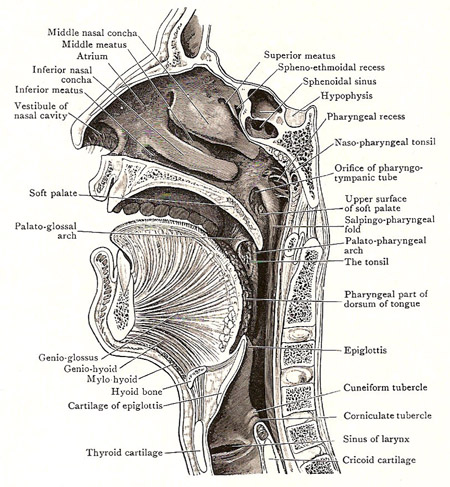soft palate

Sagittal section through the nose, mouth, pharynx, and larynx, showing the soft palate (center of the diagram).
The soft palate is a movable curtain that extends downward and backward into the pharynx. During swallowing (deglutition) the soft palate is raised and helps to shut off the nasal part of the pharynx from the portion below. Anteriorly, it is attached to the posterior margin of the hard palate; on each side, it is connected with the side wall of the pharynx; and posteriorly, it presents a free border. The conical process, termed the uvula, hangs down from the middle part of the free margin; and the sharp, concave part of the margin, on each side of the uvula, becomes continuous with the palato-pharyngeal arch. The upper surface of the soft palate is convex and continuous with the floor of the nasal cavities. The inferior surface is concave of forms part of the vault of the mouth. From the posterior part of the inferior surface, on each side, a palato-glossal arch curves downward.
The soft palate is composed of a fold of mucous membrane whose two layers enclose muscular, aponeurotic (see aponeurosis), and glandular structures, together with blood vessels and nerves. The mucous membrane of the upper surface, like the nasal mucous membrane, is covered with ciliated epithelium; the mucous membrane on the lower surface lies on a thick layer of mucous palatine glands, and is covered with stratified epithelium.
The palatine aponeurosis is a tendinous sheet that lies in the anterior two-thirds of the soft palate, and is attached to the crests on the lower surface of the bony palate near its posterior edge. It thins rapidly as it extends backward, but near the bony palate, where muscle fibers are scanty, it is thick and strong; the anterior part of the soft palate is therefore more horizontal and less movable than the posterior part.
Muscles of the soft palate
The muscles of the soft palate are the levator palati and tensor palati, which descend to the palate from the base of the skull; the palato-glossus and palato-pharyngeus, which descend from it to the tongue and pharynx; and the musculus uvulae, which lies in its substance.
The palato-glossus forms a thin sheet in the lower part of the soft palate. Its fibers are partly continuous with those of the other side and are partly attached to the palatine aponeurosis. They converge to form a slender slip that descends in the palato-glossal arch to the back part of the side of the tongue, where most of it mingles with other lingual muscles, but a small bundle is inserted into the capsule of the tonsil.
The palato-pharyngeus arises from the upper surface of the palatine aponeurosis in association with the insertion of the levator palati. The fibers form a small bundle that descends over the inner surface of the constrictor in the palato-pharyngeal arch. This bundle is joined by the salpingo-pharyngeus and stylo-pharyngeus, and most of it is inserted with them into the posterior border of the thyroid cartilage. It is supplied by the accessory nerve through the pharyngeal plexus.
The two palato-pharyngei assist other muscles in elevating the pharynx and larynx during swallowing. They draw the two palato-pharyngeal arches close together like two curtains, and thus help to close the pharyngeal isthmus – the food passing down over the anterior surfaces of the approximated arches.
The salpingo-pharyngeus is a very slender muscle arising by one or two slips from the lower border of the cartilage of the pharyngo-tympanic tube near its pharyngeal end. (Salpinx means a tube.) The muscle descends over the inner surface of the superior constrictor, in the salpingo-pahryngeal fold of mucous membrane, and joins the palato-pharyngeus.
The musculus uvulae is in the form of a pair of slender slips that lie side by side under cover of the superficial fibers of the palato-pharyngeus. They arise from the posterior nasal spine, pass backward through the soft palate, unite together, and enter the uvula to be inserted into its mucous membrane. It shortens the uvula.
The levator palati, the elevator of the palate, is a rounded, fleshy slip that arises mainly from the medial surface of the cartilage of the pharyngo-tympanic tube. It passes downward and forward, crosses the upper border of the superior constrictor, pierces the pharyngo-basiliar fascia, passes below the orifice of the tube, and enters the soft palate. There, its fibers spread out and are partly inserted into the palatine aponeurosis, but, posteriorly, the majority of the fibers become continuous with the corresponding fasciculi of the opposite side.
The tensor palati, the tensor of the palate, is a thin, flat, triangular muscle that ends inferiorly in a slender tendon that turns round the root of the pterygoid hamulus to enter the palate.
Vessels and nerves of the soft palate
The ascending palatine branch of the facial artery is the principal artery of supply to the soft palate. It ascends on the side wall of the pharynx to the upper border of the superior constrictor, and then descends with the levator to the palate. The lesser palatine branches of the greater palatine artery also contribute to the supply.
The lesser palatine nerves supply the nervous membrane. The tensor palati is supplied by the mandibular nerve through the otic ganglion; all the other muscles of the soft palate are supplied by the accessory nerve by fibers that reach the pharyngeal plexus through the pharyngeal branch of the vagus.


